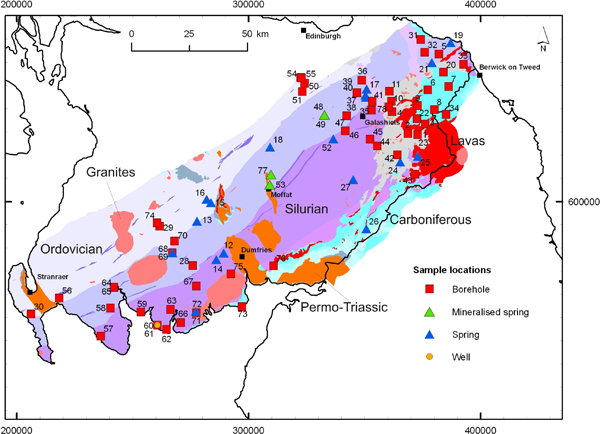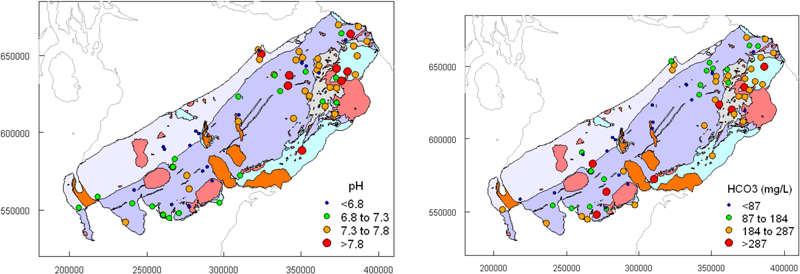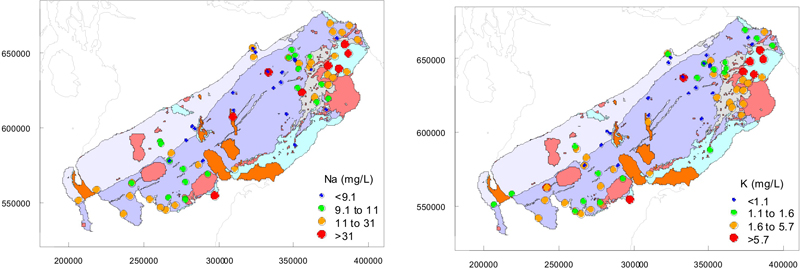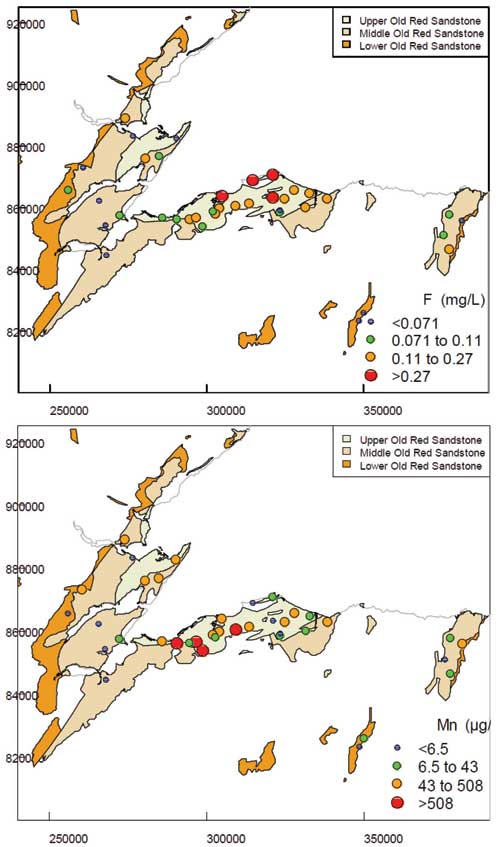A total of 78 groundwater sample analyses from the Silurian, Ordovician, Devonian, Carboniferous and igneous aquifers in southern Scotland were interpreted to investigate the groundwater chemistry of these aquifers. The samples were collected between 2002 and 2006. Permian aquifers in southern Scotland were not included in this study.

Coverage of baseline sampling in southern Scotland against the 625K geology map of the region. BGS © UKRI.
Main findings
The collection and interpretation of new groundwater chemistry data for southern Scotland has led to the following conclusions.
pH
Most of the groundwater pH values in the region are in the near-neutral range (6.5 to 8.5). Groundwaters from Ordovician and Silurian rocks tend to have a slightly lower pH than those from Devonian sandstones and Carboniferous sandstones and limestones. Groundwaters from igneous rocks and mineralised Lower Palaeozoic strata are more acidic, with occasional pH values below 6.5.
Bicarbonate alkalinity
HCO3 is in the range 100 to 250 mg/l for Ordovician and Silurian groundwaters, 200 to 320 mg/l for Devonian and Carboniferous groundwaters, and less than 100 mg/l for igneous groundwaters and mineralised springs from the lower Palaeozoic.
Chloride and sulfate
Cl and SO4 concentrations are generally low and reflect inputs from rainfall, with the exception of Carboniferous groundwaters, which tend to have highest concentrations of Cl and SO4. This possibly reflects the influence of connate water and sulfide mineralisation within interbedded mudstone.
Major cations
Concentrations of the major cations reflect a combination of rainfall input, mineral weathering, and anthropogenic inputs derived from the use of fertilisers and liming (or from other sources of pollution). Most notable is an enrichment of K (5 to 10 mg/l) in groundwaters from Carboniferous sedimentary rocks, probably resulting from feldspar weathering. Ca concentrations broadly reflect the distribution of calcite in rocks. Groundwater from Ordovician, Silurian and mineralised strata and igneous aquifers are undersaturated with respect to calcite, as would be expected from their non-carbonate mineralogy. Groundwater from the Devonian and Carboniferous strata are generally saturated or supersaturated with respect to calcite, indicating the presence of calcite either as a major (Carboniferous limestone) or minor (calcite cement in Devonian sandstones) component.
Dissolved oxygen
Most of the groundwaters in the study area are oxidising, with dissolved oxygen concentrations in the range 1 to 7 mg/l and a redox potential (Eh) greater than 300 mV. However, the mineralised springs are reducing, with sulfate reduction indicated at St Ronan’s Wells, Innerleithen. Groundwaters from Carboniferous strata in general tend to be slightly less oxidising than those from other aquifers.
Apart from these incidences, however, the groundwater redox status does not appear to vary strongly with geology.
Nitrate
Nitrate concentrations are typically low: the median concentration of nitrate in groundwater is less than 5 mg/l NO3-N across the aquifers. Concentrations are related to land use, with groundwaters beneath agricultural land showing higher concentrations than those beneath non-agricultural land. Elevated nitrate concentrations (over 5 mg/l NO3-N) are found outside the current designated nitrate vulnerable zones. The most noticeable are in the west of the study area, in Galloway, where high concentrations are associated with improved pasture, in particular dairy farming.
Phosphorus
Concentrations of phosphorus in groundwater can be an important influence on surface water eutrophication if present in baseflow to streams and rivers. Median phosphorus concentrations for the aquifer units in southern Scotland tend to fall in the range 30 to 70 μg/l-P. Phosphorus concentrations do not show any strong relationship with land use, illustrating the complexity of phosphorus geochemistry and the important role that soil geochemistry plays in the mobilisation of phosphorus into groundwater.
Interpretations in terms of groundwater flow
The hydrochemistry data and information on groundwater residence times help give an insight into groundwater flow in the different aquifers in southern Scotland. The best interpretation of the groundwater flow system within all of these aquifers is that it is largely through fractures and well mixed in the top 50 m or so. This is supported by the lack of correlation of nitrate with source depth across the region, and by the relative proportions of CFC and SF6 concentrations, which indicate mixing rather than piston flow models.
There is no evidence of palaeowater in the area and, where CFC and SF6 have been measured, all samples recorded some proportion of water less than 50 years old. However, even in the more fractured and less permeable lower Palaeozoic aquifers, groundwater can be resident for several decades.
Groundwater samples in the upland areas of southern Scotland often contain a large element of water that fell as rain on higher ground (as implied by depleted stable isotope data). This suggests connected groundwater systems or possibly, in some instances, re-infiltration of upland run-off into the groundwater systems.
Summary statistics
The tables provide a statistical summary of the natural variation in groundwater chemistry in each of the studied aquifers in southern Scotland: Silurian, Ordovician, Devonian and Carboniferous. Data between the 10th and 90th percentiles for each element or ion are presented, which allows the influence of outliers to be minimised. We would expect new data to plot within this range 80 per cent of the time.
The data indicates systematic variations in some solutes with geology. Most noticeable is the saturation and supersaturation of calcite in groundwater from Devonian and Carboniferous aquifers and the lack of calcite in many of the samples from the Silurian and Ordovician aquifers. Another difference is the elevation of sulfate and potassium in groundwaters from the Carboniferous aquifer compared to other waters.
Samples from igneous aquifers also have different groundwater chemistries to the main aquifers, but there are too few samples in this group to draw statistically meaningful conclusions about the expected baseline chemistry.
Concentrations in italics in the tables below are below instrumental detection limits and have been estimated using a robust ‘regression on order statistics’ approach. For further detail on this statistical approach, see the full Southern Scotland Baseline report.
Aquifer groundwater chemistry summaries
- Silurian
- Ordovician
- Devonian
- Carboniferous
- Piper diagram illustrating the distribution of groundwater chemistry data for all southern Scotland aquifers
Maps of regional variation in selected ion concentrations
Full report
You can download the Baseline Scotland: groundwater chemistry of southern Scotland report.







